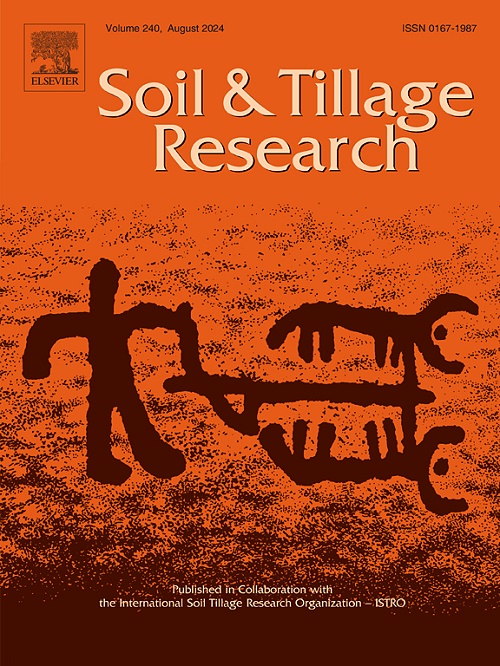Multiyear crop residue cover mapping using narrow-band vs. broad-band shortwave infrared satellite imagery
IF 6.8
1区 农林科学
Q1 SOIL SCIENCE
引用次数: 0
Abstract
Crop residue serves an important role in agricultural systems as high levels of fractional crop residue cover (fR) can reduce erosion, preserve soil moisture, and build soil organic carbon. However, the ability to accurately quantify fR at scale has been limited. In this study we produced annual maps of fR for farmland in Maryland, USA using WorldView-3 (WV3) imagery paired with on-farm photographs (n = 895) classified to fR using SamplePoint software. Univariate linear regressions were used to compare photograph fR to WV3 crop residue indices including: 1) Shortwave Infrared Normalized Difference Residue Index (SINDRI), 2) Shortwave Infrared Difference Residue Index (SIDRI), 3) Normalized Difference Tillage Index (NDTI), and 4) Shortwave Infrared Angle Index (SWIRA). SINDRI and SIDRI are based on narrow bands capable of measuring lignocellulose absorption features. NDTI and SWIRA are based on Landsat-comparable broad bands. Our findings demonstrated that SINDRI outperformed other indices in fR estimation in terms of coefficient of determination (R2 = 0.869) and root mean square error (RMSE = 0.111), when R2 and RMSE were averaged across six individual years. For a univariate analysis combining five years of high-quality WV3 imagery, SINDRI again exhibited the highest fR estimation performance (R2 = 0.795; RMSE = 0.141), suggesting that SINDRI can map fR accurately with a singular relationship, potentially reducing the need for labor-intensive ground data collection. For broad-band indices, a multiple linear regression analysis that included a Water Index (WI) and Normalized Difference Vegetation Index (NDVI) as additional predictors increased the accuracy of fR estimation significantly, particularly for SWIRA (R2 = 0.767; RMSE = 0.144), but also NDTI (R2 = 0.654; RMSE = 0.174). Our findings suggest that while indices computed from narrow-band imagery are most accurate for fR estimation, SWIRA has the potential to improve fR estimation compared to NDTI, especially when used in conjunction with WI and NDVI. An index suite of SWIRA, WI, and NDVI can be computed with Landsat 4–9 imagery, providing a more accurate record of global fR dating back to 1982.
使用窄带与宽带短波红外卫星图像绘制多年作物残茬覆盖图
作物残茬在农业系统中发挥着重要作用,因为高水平的作物残茬覆盖度(fR)可以减少侵蚀,保持土壤水分,并建立土壤有机碳。然而,大规模准确量化fR的能力有限。在这项研究中,我们使用WorldView-3 (WV3)图像与使用SamplePoint软件分类为fR的农场照片(n = 895)配对,制作了美国马里兰州农田fR的年度地图。采用单变量线性回归比较照片fR与WV3作物残茬指数,包括:1)短波红外归一化残茬指数(SINDRI)、2)短波红外归一化残茬指数(SIDRI)、3)归一化耕作差异指数(NDTI)和4)短波红外角度指数(SWIRA)。SINDRI和SIDRI基于能够测量木质纤维素吸收特征的窄带。NDTI和SWIRA基于与陆地卫星相当的宽带。我们的研究结果表明,当R2和RMSE在6个个体年平均时,SINDRI在fR估计方面的决定系数(R2 = 0.869)和均方根误差(RMSE = 0.111)优于其他指标。对于结合5年高质量WV3图像的单变量分析,SINDRI再次表现出最高的fR估计性能(R2 = 0.795;RMSE = 0.141),表明SINDRI可以以单一关系准确地绘制fR,从而可能减少对劳动密集型地面数据收集的需求。对于宽带指数,包括水指数(WI)和归一化植被指数(NDVI)作为额外预测因子的多元线性回归分析显著提高了fR估计的准确性,尤其是SWIRA (R2 = 0.767;RMSE = 0.144), NDTI也有差异(R2 = 0.654;Rmse = 0.174)。我们的研究结果表明,虽然从窄带图像计算的指数对于fR估计是最准确的,但与NDTI相比,SWIRA有可能改善fR估计,特别是当与WI和NDVI结合使用时。SWIRA, WI和NDVI的索引套件可以用Landsat 4-9图像计算,提供自1982年以来更准确的全球fR记录。
本文章由计算机程序翻译,如有差异,请以英文原文为准。
求助全文
约1分钟内获得全文
求助全文
来源期刊

Soil & Tillage Research
农林科学-土壤科学
CiteScore
13.00
自引率
6.20%
发文量
266
审稿时长
5 months
期刊介绍:
Soil & Tillage Research examines the physical, chemical and biological changes in the soil caused by tillage and field traffic. Manuscripts will be considered on aspects of soil science, physics, technology, mechanization and applied engineering for a sustainable balance among productivity, environmental quality and profitability. The following are examples of suitable topics within the scope of the journal of Soil and Tillage Research:
The agricultural and biosystems engineering associated with tillage (including no-tillage, reduced-tillage and direct drilling), irrigation and drainage, crops and crop rotations, fertilization, rehabilitation of mine spoils and processes used to modify soils. Soil change effects on establishment and yield of crops, growth of plants and roots, structure and erosion of soil, cycling of carbon and nutrients, greenhouse gas emissions, leaching, runoff and other processes that affect environmental quality. Characterization or modeling of tillage and field traffic responses, soil, climate, or topographic effects, soil deformation processes, tillage tools, traction devices, energy requirements, economics, surface and subsurface water quality effects, tillage effects on weed, pest and disease control, and their interactions.
 求助内容:
求助内容: 应助结果提醒方式:
应助结果提醒方式:


